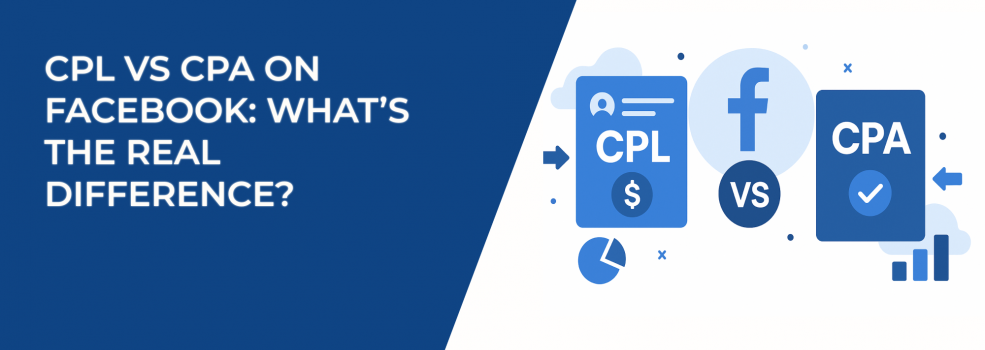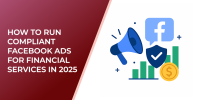When you’re running Facebook ads, every click and every dollar counts. Marketers often throw around terms like CPL (Cost per Lead) and CPA (Cost per Action), but what do they really mean in practice? And even more importantly, how do you know which one deserves your attention if you want campaigns that don’t just look good on paper but also generate real business growth?
Let’s go deeper into these metrics — because understanding them is more than just knowing the acronyms.
What Is CPL on Facebook?
CPL stands for Cost per Lead, and it measures the price you pay for each person who enters your pipeline. This could be through a lead form, a sign-up, or even a quiz result that collects contact information.
On the surface, CPL feels simple. Spend money, collect leads, measure the cost. But there’s a catch: not all leads are equal. Ten cheap leads who never open your emails are worth less than three expensive leads who actually convert.
For example:
-
If you spend $500 on Facebook ads and generate 50 leads, your CPL is $10.
-
If you refine your targeting and still spend $500 but get 100 leads, your CPL drops to $5.
That looks like a win, right? But only if those leads eventually turn into revenue. Otherwise, you’ve just bought names for a list.
The critical insight here: CPL should never be evaluated in isolation. It’s best used to compare campaigns aimed at the same audience type and conversion goal, not as a universal measure of success. For more on this, check out our piece on Mastering Lead Generation in 2025: Top Tactics for Success.
What Is CPA on Facebook?
CPA stands for Cost per Action, sometimes also called Cost per Acquisition. It reflects how much you pay for a specific, meaningful result — usually a purchase, subscription, or other bottom-of-the-funnel action.
While CPL is about interest, CPA is about commitment.
Here’s an example:
-
Spend $1,000 on ads.
-
Get 20 completed purchases.
-
Your CPA is $50.
This metric tends to be stricter. You can’t inflate it with people who never intended to buy — you either get the conversion or you don’t.
The catch? CPA often looks higher than CPL, but it’s directly tied to revenue. A $50 CPA might look heavy until you realize the average order value is $200. Suddenly, it makes sense. If you’ve ever wondered why some campaigns succeed despite “expensive” numbers, our breakdown on How to Analyze Facebook Ad Performance Beyond CTR and CPC can help.
CPL vs CPA: Which One Matters More?
It’s tempting to crown one of these metrics as the “winner,” but the reality is more nuanced. Your business type, sales cycle, and campaign strategy dictate which one to emphasize.
-
CPL works best for businesses with longer decision-making cycles, such as real estate, financial services, or coaching. Here, building a pool of leads is essential because only a fraction will convert over time.
-
CPA works best for businesses with shorter purchase cycles, such as e-commerce, subscription apps, or online courses. Every dollar should be judged by how much revenue it directly generates.
Ask yourself: are you trying to build relationships that pay off later, or are you aiming for fast, trackable sales today?
The smartest marketers don’t ignore either. They use CPL to measure pipeline efficiency and CPA to gauge profitability. Together, they act like two lenses that sharpen the view of your campaign performance. If you’re still weighing which metric deserves your focus, our detailed comparison in CPA vs CPL: Which Metric Should You Optimize For? is worth a read.
Why Both Metrics Matter Together
A common mistake is celebrating one number without checking the other. That’s where advertisers burn cash.
-
A low CPL might feel great — “I’m generating leads at just $4 each!” — but if those leads never convert, the money’s gone.
-
A high CPA might look scary at first, but if customer lifetime value (LTV) is high, the math works. Paying $70 to acquire a customer who spends $500 in a year is a fantastic trade-off.
The key takeaway: CPL tells you how efficiently you’re filling your funnel. CPA tells you whether those leads are turning into real revenue. If you’re building a more advanced funnel, our guide on Facebook Ads Funnel Strategy: From Audience Identification to Conversion shows how to connect both metrics with each funnel stage.
How to Lower CPL Without Sacrificing Lead Quality
CPL can spiral out of control if you’re targeting too broadly or using weak creatives. But cheap leads don’t guarantee value either. The goal is balance — attract affordable leads who actually belong in your funnel.
Here are a few ways to do that:
-
Dial in your audience targeting
Stop chasing the largest audience possible. Use layered targeting or lookalike audiences based on existing customers to improve quality. Explore methods like Interest Stacking to refine segmentation. -
Run pre-qualifying ads
A free quiz, a mini-guide, or a short explainer video can weed out unqualified clicks. People who make it through are more likely to convert later. -
Test lead form length
A short form may boost quantity, but a slightly longer one (asking 2–3 key questions) can improve quality. Don’t be afraid to experiment. You’ll find more ideas in What Makes a Facebook Lead Form Convert? 5 Key Optimization Tips.
The sweet spot is different for every business, but the principle stays the same: don’t just chase the lowest CPL — chase the right CPL.
How to Keep CPA Profitable on Facebook
CPA is closer to the money, so getting it right makes the difference between scaling campaigns or shutting them down. If it’s too high, your ads can eat profits fast.
To bring it under control, try these approaches:
-
Optimize your landing pages
If users click your ad but abandon the page, your CPA shoots up. Test your headline, page speed, form placement, and calls to action. For quick inspiration, see Optimizing for Post-Click Experience: What Happens After. -
Track the full funnel
Don’t just measure CPA at the final purchase. Break it down into micro-conversions (add-to-cart, checkout, trial signup). This shows where people drop off and where you can fix leaks. -
Match ad intent with offer
If your ad copy promises one thing but the landing page delivers another, conversion rates will tank. Alignment is critical. For tips on connecting audience psychology with offers, explore The Psychology of Facebook Ads: How to Hook Your Target Audience in Seconds.
A healthy CPA doesn’t just happen on the ad level. It’s the result of strong alignment between audience, creative, and conversion path.
The Overlooked Factor: Customer Lifetime Value
Here’s something many advertisers miss: CPA is meaningless without customer lifetime value.
If you only look at the first purchase, you might panic at a $60 CPA on a $50 product. But what if 40% of those customers buy again within three months? Suddenly, that $60 CPA delivers $150 in revenue.
This is why smart marketers combine CPL, CPA, and LTV into one bigger equation. They understand that ads are rarely about quick wins — they’re about sustainable profit over time. For more guidance, read How to Analyze Campaign Performance Beyond ROAS: The Full Funnel View.
Final Thoughts
CPL and CPA aren’t rivals — they’re complementary. CPL shows the cost of filling your funnel. CPA reveals the cost of turning those leads into paying customers.
Ignore one, and you risk losing sight of the big picture. Balance both, and you’ll be able to make smarter decisions about budget allocation, audience targeting, and long-term profitability.
So the next time you review your Facebook campaigns, don’t just ask “What’s my CPL?” or “What’s my CPA?” Instead, ask: How do these numbers work together to show whether I’m building a profitable growth engine?
That’s the real difference.

